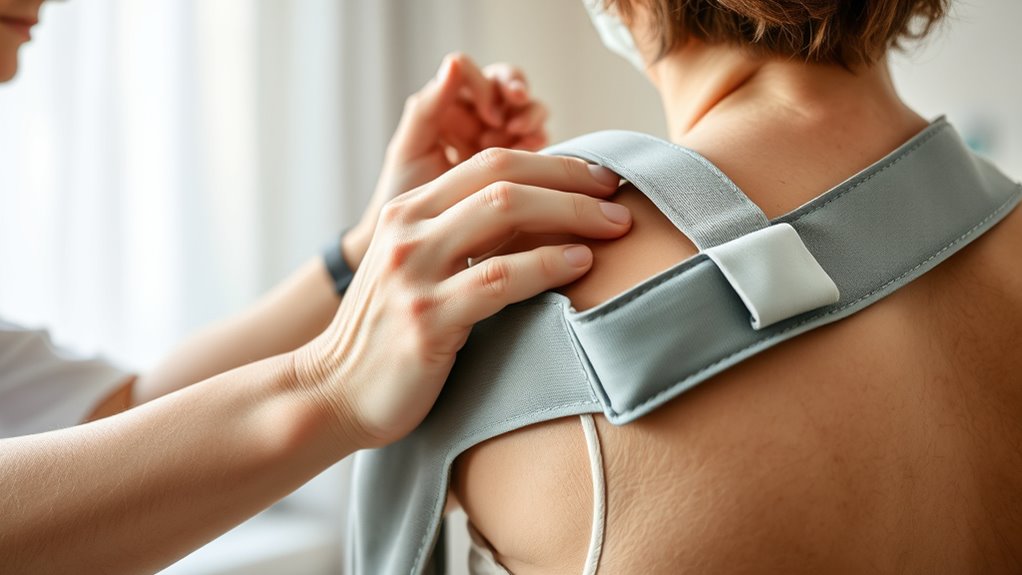To prevent post-stroke shoulder pain and subluxation, you should focus on early assessment, proper positioning, and support techniques. Keep the affected arm supported, aligned, and relaxed during transfers and rest. Incorporate gentle therapeutic exercises to strengthen shoulder muscles and prevent instability. Use assistive devices like slings or orthoses properly and communicate clearly with the patient. Continuous monitoring and multidisciplinary care help address risk factors early. Discover more ways to protect shoulder health effectively.
Key Takeaways
- Maintain proper shoulder positioning and support during rest and movement to prevent subluxation and pain.
- Regularly assess and monitor shoulder stability and muscle strength for early detection and intervention.
- Use supportive devices like slings and orthoses correctly fitted to promote joint stability and prevent injury.
- Implement gentle, targeted therapeutic exercises to strengthen shoulder muscles and improve stability gradually.
- Educate patients and caregivers on safe handling, positioning, and activity modifications to minimize shoulder risk factors.
Understanding the Causes of Shoulder Problems After Stroke

After a stroke, shoulder problems often develop because of nerve damage and muscle weakness that disrupt normal movement and support. When nerves are injured, your brain may no longer send proper signals to your shoulder muscles, leading to weakness and poor coordination. This nerve damage can also interfere with the body’s natural ability to recover muscle function over time. Nerve injury can cause pain that discourages movement, leading to stiffness and further muscle deterioration. Muscle weakness reduces your ability to stabilize your shoulder during activities, so even simple tasks can become painful or difficult. Without proper support, your shoulder joint becomes vulnerable to injury, inflammation, and pain. Incorporating appropriate therapy techniques can help improve muscle strength and coordination, reducing the risk of complications. Engaging in targeted exercises and rehabilitation strategies can further enhance recovery and prevent long-term issues. Recognizing the importance of early intervention can significantly improve outcomes and prevent chronic shoulder problems. Additionally, understanding post-stroke muscle dynamics can help tailor more effective treatment plans. Recognizing these causes helps you take steps to protect your shoulder and prevent complications.
Recognizing Risk Factors for Shoulder Pain and Subluxation

Recognizing the risk factors for shoulder pain and subluxation is essential for preventing complications after a stroke. You should watch for factors like severe paralysis or weakness on one side, as these increase the risk of subluxation. Poor shoulder stability, especially when the arm is unsupported or improperly positioned, also raises concern. Additionally, neglecting proper positioning during daily activities or therapy can lead to muscle imbalances, making injury more likely. Spasticity and poor motor control contribute to abnormal shoulder movements, heightening the risk. Age and pre-existing shoulder issues can further complicate recovery. Recognizing the role of guidance and support from loved ones can promote better adherence to preventive strategies. By identifying these risk factors early, you can implement targeted strategies to reduce the likelihood of pain and subluxation, promoting better recovery and functional use of the affected limb.
The Importance of Early Assessment and Monitoring
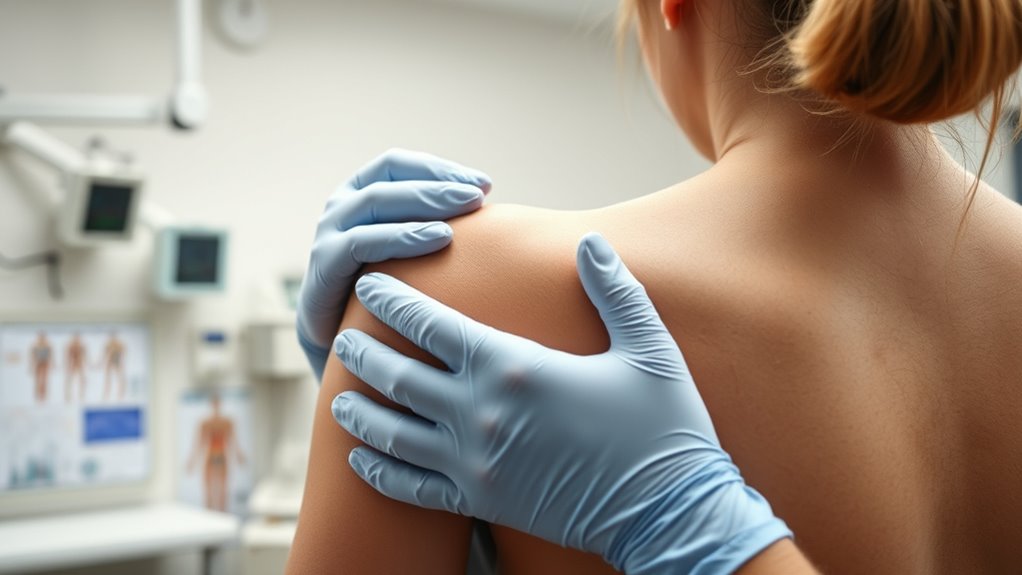
Getting evaluated early after a stroke helps identify potential shoulder issues before they worsen. Regular monitoring allows you to catch problems early and adjust your care plan as needed. This proactive approach can substantially reduce the risk of developing post-stroke shoulder pain. Additionally, understanding anatomy and movement patterns can aid in designing targeted therapies to prevent shoulder complications. Incorporating automation in healthcare can also assist in tracking recovery progress and optimizing treatment plans. Recognizing the importance of early intervention can further enhance outcomes and prevent long-term disability. Being aware of large number conversions can facilitate better communication of progress and data interpretation among healthcare teams, especially when utilizing sophisticated projector technology for educational or telemedicine purposes.
Timely Post-Stroke Exams
Timely post-stroke exams are essential for preventing shoulder pain because early assessment helps identify potential issues before they worsen. By evaluating shoulder function early, you can catch signs of subluxation or muscle weakness, allowing for prompt intervention. Regular exams also help track progress and adjust treatments as needed. This proactive approach reduces the risk of long-term pain and disability.
| Benefits of Early Exams | Key Actions to Take |
|---|---|
| Detect issues early | Schedule assessments within days post-stroke |
| Prevent complications | Monitor shoulder alignment regularly |
| Guide treatment plans | Use targeted exercises and interventions |
| Improve recovery | Coordinate with your healthcare team |
Continuous Monitoring Benefits
Continuous monitoring builds on early post-stroke exams by providing ongoing insights into shoulder health, allowing you to detect problems as they develop. With regular assessments, you can identify signs of subluxation or pain before they worsen. This proactive approach helps you catch issues early, enabling timely interventions that can prevent long-term damage. Continuous monitoring also helps you track progress and adjust treatments as needed, ensuring that your recovery stays on course. By staying vigilant, you reduce the risk of complications and improve your chances of regaining full shoulder function. Overall, ongoing observation empowers you to manage your shoulder health effectively, minimizing discomfort and enhancing your recovery process. It’s an essential step toward preventing post-stroke shoulder pain and subluxation.
Proper Positioning and Support Techniques
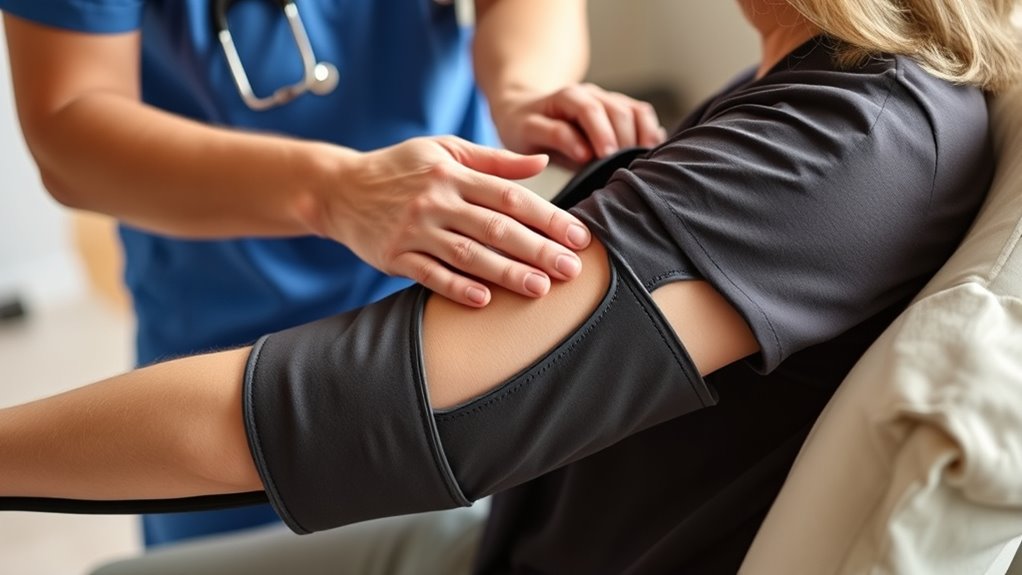
Proper positioning and support are essential in preventing post-stroke shoulder pain, especially as improper alignment can lead to joint stress and discomfort. When you position the affected arm, keep it in a neutral or slightly elevated position to avoid excessive downward pull. Use supportive devices like slings or cushions to maintain proper shoulder alignment, ensuring the shoulder doesn’t hang or droop. Regularly check that the arm is supported during rest and transfers, avoiding positions that strain the joint. Keep the shoulder relaxed and avoid overstretching or pulling. Proper positioning reduces undue stress on the shoulder structures, helping prevent subluxation and pain. Incorporating supportive techniques can further enhance joint stability during recovery. Additionally, maintaining proper posture can prevent compensatory movements that might lead to discomfort. Paying attention to proper positioning and supporting the affected limb consistently can significantly improve recovery outcomes and reduce the risk of complications. Furthermore, understanding the importance of muscle relaxation can help in minimizing tension around the joint and promote healing. Engaging in gentle, guided exercises can also support muscle balance and joint integrity during rehabilitation.
Therapeutic Exercises to Strengthen Shoulder Muscles
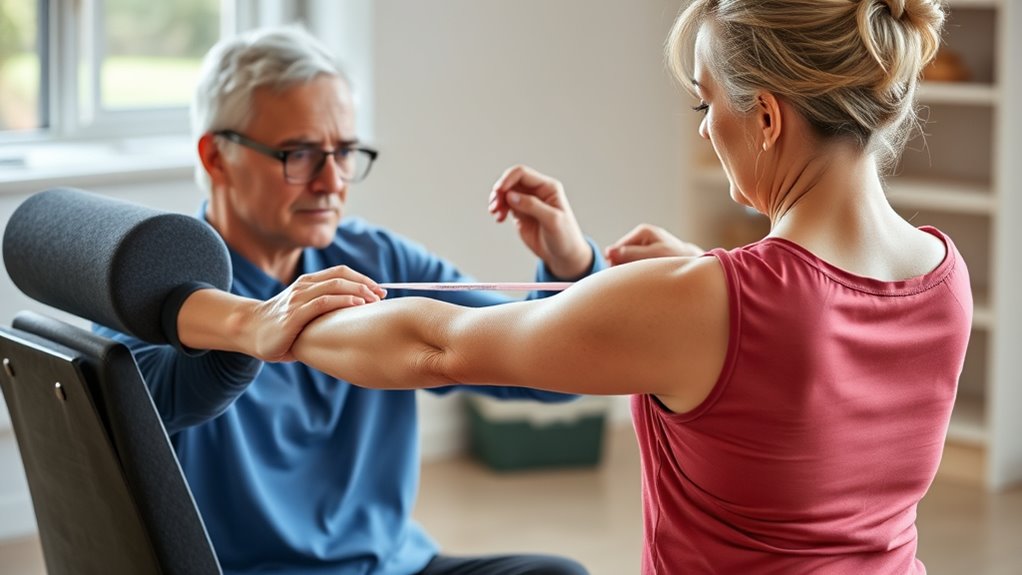
Therapeutic exercises are a key component in rebuilding shoulder strength and stability after a stroke. These exercises target weakened muscles, helping prevent subluxation and pain. You can start with passive exercises, gradually progressing to active-assisted and active routines as your strength improves. Consistency is vital; perform exercises regularly to see meaningful progress. Proper technique is essential to avoid injury and ensure effectiveness. Incorporate exercises that engage the rotator cuff, deltoid, and scapular stabilizers. Being aware of local store hours can help you plan your therapy sessions around available resources and avoid unnecessary delays. Understanding alimony laws can assist in planning your financial stability during recovery and post-rehabilitation. Including elements of Italian Cuisine, such as the use of aromatic herbs and gentle preparation techniques, can inspire a calming and enjoyable approach to your exercise routine. Additionally, choosing organic fruits and vegetables for your post-exercise nutrition can enhance recovery and overall health. Incorporating skincare routines can also support skin health and comfort during your recovery period.
Strategies for Safe Handling and Transfer of Patients

Ensuring safe handling and transfer of patients is essential to prevent injuries for both the patient and caregiver. Always plan before moving a patient, evaluating their level of assistance needed. Use proper body mechanics by keeping your back straight, bending your knees, and engaging your core muscles. Support the patient’s affected arm and shoulder to prevent subluxation, avoiding pulling or lifting by the shoulder alone. Communicate clearly with the patient, explaining each step to promote cooperation. Use smooth, controlled movements, and avoid sudden jerks or twists. When transferring from bed to chair or wheelchair, lock wheels and position supports correctly. Always seek help if the task exceeds your capacity. Incorporating proper handling techniques can significantly reduce the risk of injury and ensure a safe, comfortable transfer. Understanding potential risks associated with patient transfers and how to mitigate them can help in planning safer procedures. Additionally, being aware of post-stroke shoulder management and proper positioning can further prevent complications such as pain and subluxation.
The Role of Assistive Devices and Orthoses

Using assistive devices and orthoses can markedly reduce shoulder pain after a stroke. Make sure these tools fit properly to avoid unnecessary pressure or discomfort. Proper support helps stabilize the shoulder and prevents injuries that can lead to pain.
Proper Device Fitting
Proper device fitting is essential to prevent post-stroke shoulder pain, as ill-fitting assistive devices and orthoses can cause unnecessary strain and discomfort. When your devices fit poorly, they may rub against sensitive areas or shift unexpectedly, increasing the risk of pain and subluxation. To ensure ideal fit, you should regularly check for pressure points, loosen or tighten straps as needed, and consult with a healthcare professional for adjustments. Proper fitting also involves considering the device’s position relative to your body, ensuring it supports correct alignment without restricting movement or circulation.
- Regularly inspect for signs of pressure or skin irritation
- Adjust straps and straps tension for comfort and security
- Choose adjustable devices to accommodate changes in swelling or muscle tone
- Seek professional guidance for proper alignment and fit
Supporting Shoulder Stability
Assistive devices and orthoses play a crucial role in supporting shoulder stability after a stroke. They help prevent subluxation by maintaining proper joint alignment and reducing undue strain on shoulder structures. Using shoulder slings, you can support the arm in a position that minimizes gravity’s pull, especially during activities or rest. Orthoses like shoulder orthoses or abduction braces can limit excessive movement, providing stability during functional tasks. Make sure these devices are properly fitted to avoid discomfort or skin issues. Regular use, combined with proper positioning and therapy, promotes joint integrity and prevents pain. Remember, the goal is to support natural movement while protecting the shoulder from subluxation and pain, enhancing your recovery and functional independence.
Incorporating Pain Management and Comfort Measures

To effectively prevent post-stroke shoulder pain, incorporating pain management and comfort measures into your care plan is essential. These strategies can reduce discomfort, promote healing, and improve overall function. Begin with regular assessment of pain levels to identify issues early. Use appropriate techniques like gentle massage, positioning, and thermal therapies to ease muscle tension. Ensuring proper support with pillows or splints can prevent unnecessary strain. Educate yourself on safe movement practices to avoid aggravating pain. Additionally, consider non-pharmacological options such as relaxation techniques or distraction methods to help manage discomfort. Incorporating proper support devices can also help prevent subluxation and further injury.
Developing a Multidisciplinary Prevention Plan
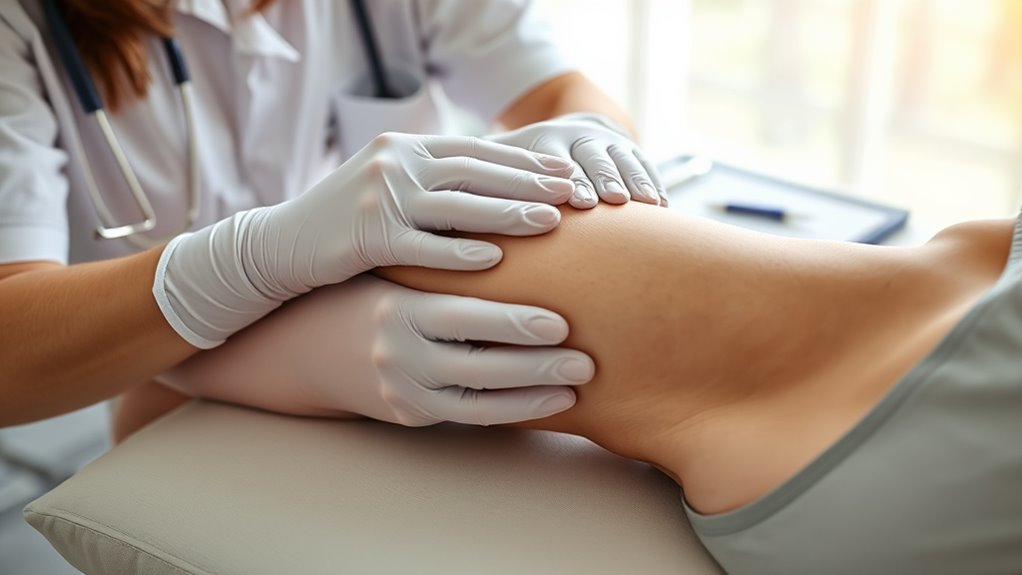
Developing a multidisciplinary prevention plan requires coordinated efforts among healthcare professionals, patients, and caregivers to effectively address post-stroke shoulder pain. Start by assembling a team that includes physicians, therapists, nurses, and caregivers, each bringing their expertise. Establish clear goals focused on early assessment, pain prevention, and joint protection. Regular communication ensures everyone stays updated on the patient’s progress and adjustments needed. Educate the patient and caregivers about proper positioning, safe handling, and activity modifications. Incorporate evidence-based interventions like proper positioning, early mobilization, and targeted exercises. Consistent monitoring helps identify issues early and adapt the plan as the patient recovers. A collaborative approach minimizes risks, promotes recovery, and greatly reduces the likelihood of shoulder pain and subluxation post-stroke.
Frequently Asked Questions
How Can Caregivers Effectively Communicate With Stroke Patients About Shoulder Discomfort?
You can effectively communicate with stroke patients about shoulder discomfort by using simple language and gentle tone. Ask open-ended questions to encourage them to share their feelings, and listen actively when they describe pain or tightness. Use visual cues or demonstrations if needed, and reassure them that their discomfort is important. Always be patient, attentive, and supportive, helping them feel safe discussing their symptoms openly.
Are There Specific Exercises Suitable for Different Stages of Stroke Recovery?
Think of your recovery as gentle steps along a path. In early stages, focus on passive movements to gently wake your muscles. As you progress, incorporate assisted exercises to rebuild strength. Later, move to active routines that promote independence. Always listen to your body and consult your healthcare team. Each stage requires tailored activities, helping you regain function gradually while reducing discomfort and preventing complications.
What Signs Indicate the Need for Immediate Medical Intervention for Shoulder Issues?
If you notice sudden, severe shoulder pain, intense swelling, or your shoulder turns purple or blue, seek medical help immediately. Also, if you experience difficulty moving your arm, numbness, or if your shoulder feels dislocated or feels worse after movement, don’t hesitate in getting emergency care. Acting quickly can prevent further damage, reduce pain, and ensure proper treatment to protect your shoulder’s health.
How Do Cultural Beliefs Influence Acceptance of Prevention Strategies?
You might find that cultural beliefs shape how you view prevention strategies. If your culture values traditional healing or has mistrust toward medical interventions, you may hesitate to follow recommended practices. Respecting these beliefs, you can seek culturally sensitive education and involve community leaders. Embracing strategies that align with your values can improve acceptance and effectiveness, helping you better protect your shoulder health post-stroke.
What Are the Latest Innovations in Assistive Technology for Shoulder Protection?
You can benefit from the latest innovations in assistive technology for shoulder protection, such as smart braces with sensors that monitor shoulder positioning and alert you to avoid subluxation. Advances include lightweight, adjustable supports designed for comfort, and wearable devices that track movement patterns to prevent strain. These innovations aim to enhance your safety and independence by providing real-time feedback and personalized support, helping you manage shoulder health effectively.
Conclusion
By understanding the causes and risk factors of post-stroke shoulder issues, you can proactively prevent pain and subluxation. Early assessment, proper positioning, and tailored exercises are key. Incorporating assistive devices and a multidisciplinary approach guarantees thorough care. Curiously, some studies suggest that regular, gentle movement stimulates nerve regeneration, supporting the idea that active engagement may not only prevent complications but also promote healing. Stay vigilant and proactive to protect your patient’s shoulder health.
